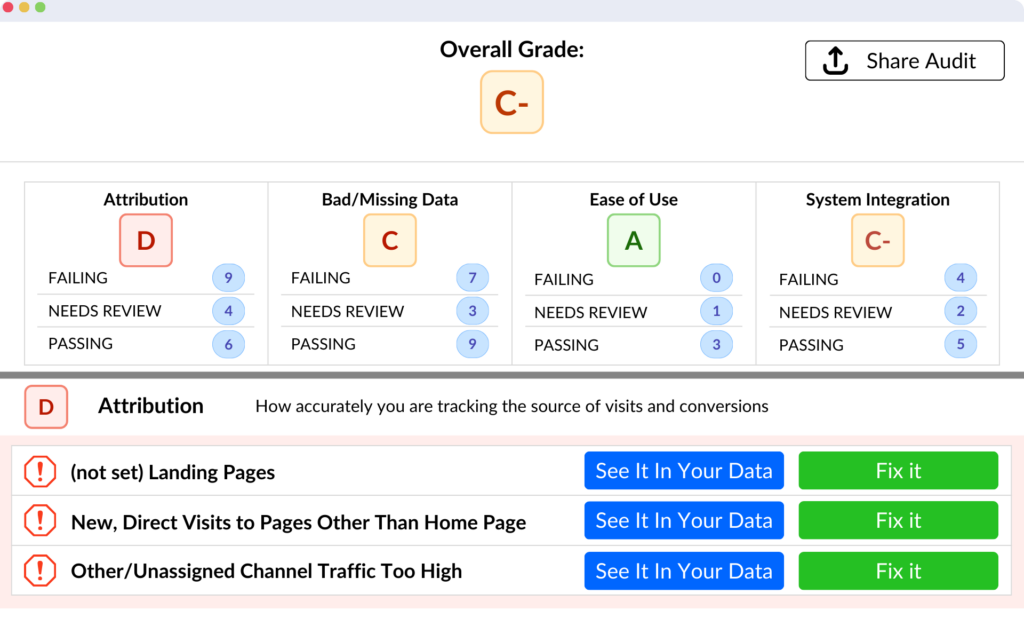Today, we’re diving into a topic that has haunted digital marketers for years: channel groupings. If you’re feeling a mix of dread and confusion, you’re not alone.
Think of channel groupings like the messy closet in your marketing analytics house. You keep shoving things in, hoping to sort it out “later,” and before you know it, the clutter is out of control. Nearly every brand we work with has a cluttered analytics closet—and it’s not because they don’t have smart people on their team. It’s because there are so many ways things can go wrong.
Today, we’re going to tackle this head-on. We’ll break down where channel groupings go wrong, why it matters, and most importantly, how you can organize this chaos to unlock better insights. Trust me—getting this right is like finally finding that missing sock you’ve been searching for.
Where Things Go Wrong: The Origins of Poor Channel Groupings

So, why are channel groupings such a mess? A big part of the problem started years ago, back when digital marketing was still getting its footing. CFOs were allocating budgets and needed a simple answer to the question: “What did we get for the money we spent?” Back then, marketers lumped all their paid media into a single bucket to give a quick number back to leadership. That worked at first, but it set up some bad habits.
As platforms evolved, with new ways to target and segment audiences, many marketers didn’t evolve their groupings along with them. They kept rolling things up into one number without realizing that they were missing out on the insights that could actually improve their marketing performance.
Another big issue? The platforms themselves weren’t set up for this level of detail when digital marketing first started exploding. Even as more sophisticated tracking tools emerged, they weren’t necessarily optimized to help you see how granular you could get with your data.
Understanding Slices and Segments

All right, let’s cut through some of the jargon. If you’ve ever worked with data engineers or analytics teams, you’ve probably heard them talk about “slices,” “segments,” and “dimensions,” and you might have gotten a blank stare trying to make sense of it all. So, let’s make it simple.
- Metrics are things you can count. Think users, sessions, purchases, or leads. Those are all metrics—concrete numbers that track your outcomes.
- Dimensions (or slices, if you want a more digestible term) are the categories you use to break those numbers apart. For example, you can slice users by where they came from (like a paid search campaign), by what device they used (mobile vs. desktop), or by whether they’re a new or returning customer.
Having good slices is crucial. Without them, you’re basically just staring at a pile of numbers with no way to figure out what’s working and what’s not. Slicing your data correctly lets you uncover actionable insights—the kind that help you optimize your campaigns and drive better performance.
Why Default Channel Groupings Fail

Now, let’s talk about default channel groupings, like the ones you get in Google Analytics. At first glance, they seem helpful—Google Analytics gives you groupings like paid search, paid social, organic search, and more. But here’s the problem: they’re grouped based on where you spent money, not why.
For example, you might be running ads on YouTube targeting two very different audiences—people who’ve never heard of your brand (prospecting) and people who’ve already interacted with your site (retargeting). These are two completely different strategies, yet Google’s default grouping throws them into the same “paid video” bucket.
Another classic mistake is lumping branded and non-branded paid search together. If someone’s searching for your brand name, they’re already aware of you—those leads are much easier to convert. But if someone is searching a general term, like “best camping tents,” that’s an upper-funnel search and a different beast altogether. If you treat them the same, you’ll miss key performance differences and opportunities to optimize.
What Good Channel Groupings Look Like

So, what does a good channel grouping look like? It starts with grouping campaigns by intent, not just by the platform or vendor where you’re spending money.
Here are a few examples of how to group channels more effectively:
- Paid Search:
- Branded vs. Non-Branded
- Competitor search terms
- Paid Video:
- Prospecting (new audience)
- Retargeting (existing audience)
- Display Ads:
- Prospecting vs. Retargeting
- Email:
- Transactional vs. Promotional
- Prospecting vs. Customer Nurturing
By segmenting based on intent, you can start to see where your money is working hardest and where you might need to adjust. For example, your ROI on branded paid search will always look better than on non-branded—because branded searches are lower in the funnel. When you separate them, you get a clearer view of what’s really happening.
The Logic Behind Direct Traffic & Attribution Loss

Let’s shift gears for a moment to talk about one of the most common issues we see with channel groupings: direct traffic. Have you ever logged into your analytics and seen a huge chunk of your traffic listed as “direct”? It’s frustrating, right? You know people aren’t typing your URL into the browser bar every time they visit your site. So why does it happen?
The problem often comes down to how Google Analytics tracks visits. Here’s the logic Google uses to figure out where a visitor came from:
- First, it looks for a GCLID (Google Click Identifier), which tells Google the click came from an ad.
- If there’s no GCLID, it looks for UTM parameters (those little tags you put in your URLs).
- If it can’t find UTM parameters, it checks the referrer—essentially, the page that sent the visitor to you.
- If all else fails, Google throws its hands up and labels the visit as “direct.”
There are countless scenarios where this process breaks down—email links, app referrals, even redirects from HTTP to HTTPS. Each of these can strip the tracking info out of the link and throw traffic into the dreaded “direct” bucket.
Retroactive Fixes: Adjusting Channel Groupings with Modern Tools

Here’s the good news: modern tools like GA4 and BigQuery allow for retroactive fixes. Back in the day, once you set your channel groupings, you were stuck with them. If you wanted to make changes, you’d have to start tracking everything all over again. But not anymore.
With tools like late data binding, you can change how your data is grouped even after it’s been collected. Let’s say you realized six months into a campaign that you were miscategorizing some of your traffic. With a modern setup, you can adjust those categories and apply the new groupings retroactively—no need to start over.
Pro tip: Always include campaign IDs in your UTM parameters. They’ll save you a headache when campaign names change or get updated. IDs help you keep a clean and consistent connection between cost data and performance data.
Conclusion: Why Clean Channel Groupings Matter

At the end of the day, organizing your channel groupings correctly is one of the most powerful steps you can take to improve your marketing insights. When you group your campaigns based on intent, not just vendor or platform, you unlock a whole new level of understanding about how your media dollars are performing.
And let’s be honest—if your “direct” traffic is sitting at 80%, something’s definitely off. Whether it’s missing UTM tags or broken redirects, getting to the bottom of that mess will give you clearer data and better insights.
So if you’re nodding along thinking, “Yes, this is exactly what I need to fix,” we’d love to help. Head over to admindanalytics.com and schedule a discovery call with Mike and me. There’s no cost for an initial consultation, and we’ll help you start organizing that analytics closet once and for all.
Thanks for tuning in, and we’ll see you next time!










